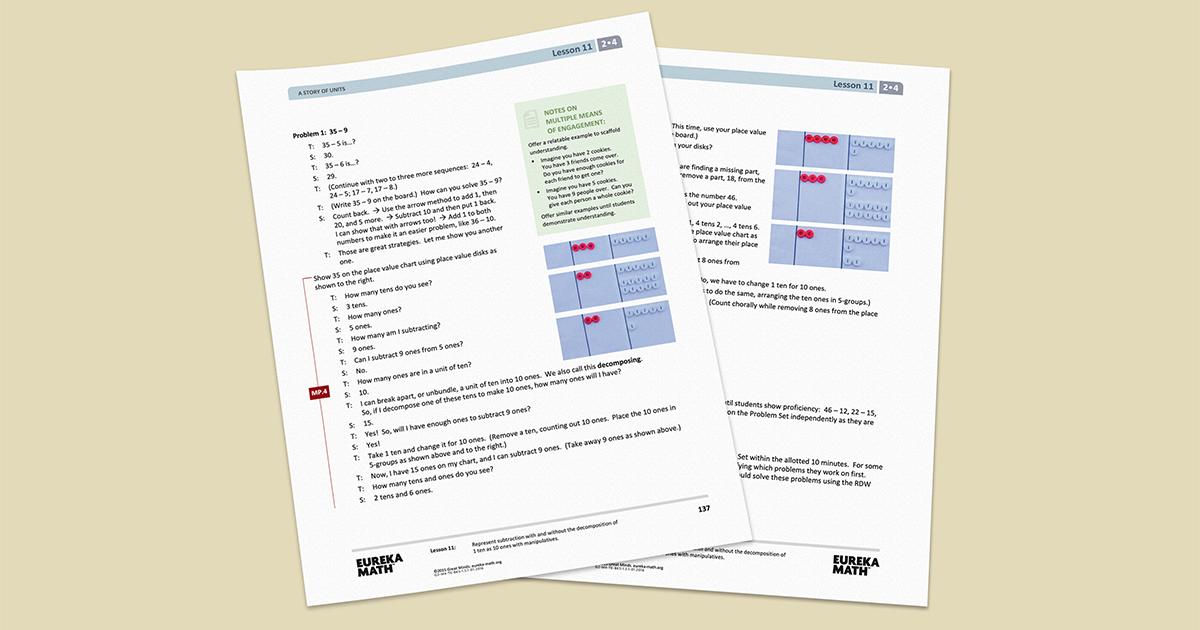Posted in: Aha! Blog > Eureka Math Blog > Implementation Support > It's Not a Script
FAQ RESPONSE
If you’ve seen the 1990 box office comedy Kindergarten Cop, then you likely recall Arnold Schwartzenegger as a teacher snapping at a precocious 5-year-old boy who suggests that his headache might be a tumor. In Schwartzenegger-speak, the teacher retorts, “It’s not a toomah!” Sometimes I wish I had the thick Austrian accent to blurt out, “It’s not a script!”

The writers of the Eureka Math® curriculum deliberately designed lessons in the style of vignettes that illustrate what interaction between teacher and student might sound like in a classroom that is rolling out a rigorous curriculum. The downside? The vignette style has created a general misunderstanding among some teachers that lessons are to be read as a script.
That was not our intent. Rather, it was to provide teachers with exemplars of instructional situations that would develop out of a lesson design that includes the following:
- A carefully crafted sequence of problems increasing in complexity.
- In many cases, movement from the concrete to pictorial to abstract.
- The terminology, language, models, and tools to say and do what is intended by the Common Core State Standards for Mathematics (CCSSM).
- Evidence of content being presented as part of a coherent story (Grades PreK–12) wherein skills build upon skills and conceptual understandings are developed as themes unfold.
If you’ve felt constrained by Eureka Math lessons, then this is good news! All of us at Great Minds® believe that teachers should customize lessons to suit the needs of their students and the culture of their school. The vignettes of student–teacher interactions are meant to spark discussion among colleagues and foster a collaborative community.
With this in mind, let’s examine a Grade 2 lesson about renaming (G2 M4 L11). After studying this lesson, teachers might highlight specific concepts and skills they want to emphasize as they guide the students through solving 35 minus 9.

This notion of composing and decomposing can be intimidating for teachers who are trained to “borrow” and “carry the one.” The instructional decisions being modeled in the vignettes are meant to provide coherent learning sequences to support teachers as they sharpen their craft and guide students along a continuum of knowledge. Through reading and studying these vignettes, I have found what a classroom that is fostering a much deeper level of understanding looks and sounds like. Because our curriculum spans Grades PreK–12, the instructional decisions presented in the vignettes stem from learning in previous grades and anticipate the work of subsequent grades. The sample dialogue is intended to unify content and make it more coherent throughout the grade levels without stifling teachers.
Teachers who are not interpreting the curriculum as a "script" are telling me that they feel supported. They feel that they have the tools to guide students on the road to a more comprehensive conceptual understanding. They also tell me that they “don’t get all of it right.” I don’t either! Sometimes it’s messy. But as a writer, I can sleep at night knowing that teachers have the help they need to feel empowered and to communicate with students in a way that honors the integrity of the standards.
This blog post was written by MaryJo Wieland, a Eureka Math writer for PreK and Grade 2.
© Great Minds 2016
Submit the Form to Print

MaryJo Wieland
Topics: Implementation Support











